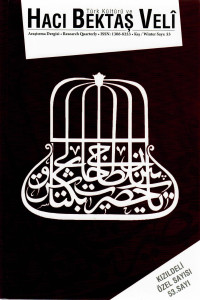Öz
Alevi- Bektaşi kultur yapısı icinde şiir ve şiir turlerinin yeri cok onemlidir. Cunku bu kulture ait oğretilerin hem yaşatılması hem de nesilden nesle aktarılması bakımından şiire ihtiyac duyulmaktadır. Şiirler kimi zaman bestelenmiş şekli kimi zamansa sozlu olarak cemlerde okunmakta, bu yolla kulture ait ozelliklerin hatırlanması sağlanmaktadır. Şiir turleri icinde Alevi- Bektaşi oğretisi icin en onemli olan tur “nefes”tir. Bugun bircok Alevi topluluğu ifade edilen şiirlerin tamamını “nefes” olarak nitelendirmekte ve oğretinin aktarım aracı olarak nefeslere buyuk onem vermektedir. Anadolu’da yaşayan her Alevi ocağı bu tur nefeslere sahiptir ve kendi ocaklarını temsilen bu nefesleri yaşatmaktadır. Bugun Kızıl Deli Ocağı olarak gecen ve Hacı Bektaş Veli Dergahı’ndaki 12 posttan biri olan “Aşcı Postu”, Kızıl Deli Sultan’a ait olduğu bilinen ocakta da okunan nefesler mevcuttur. Bu calışmada kızıl deli ocağına ait nefeslerin derlemesine yer verilmiştir.
Kaynakça
- DERGÂH. (1990). Türk Dili ve Edebiyatı Ansiklopedisi, c.7.
- GÖLPINARLI, Abdülbaki. (1963). Alevî-Bektaşî Nefesleri. İstanbul.
- KILIÇ, Filiz (2006). Bektaşi Nefesleri Ve Çalçakırlar Köyündeki Örnekleri, Türk Kültürü ve Hacı Bektaş Veli Araştırma Dergisi Yıl: 13 • Sayı: 39, Temmuz-Ağustos-Eylül- 2006
- KOCA, Turgut. (1987). Güldeste, Nefesler, Ezgiler. Ankara..
- KOCA, Turgut. (1990). Bektaşi Alevi Şairleri ve Nefesleri (13.yy.dan 20.yy.a Kadar). İstanbul: Maarif Kütüphanesi ve Matbaası A.Ş
- YILDIRIM, Rıza (2007): Rumeli’nin Fethinde ve Türkleşmesinde Öncülük Etmiş Bir Gâzi Derviş Seyyid Ali Sultan (Kızıldeli) ve Velâyetnâmesi, Ankara, Türk Tarih Kurumu Yayınları.
Öz
Poem and the types of poetry have an important place in Alevi-Bektashi culture. Poem is needed in order to transfer doctrine belonging to this culture and keep them alive. The poems are sometimes sung in a musical way or read orally in cem rituals, so cultural components of this culture are remembered. Among these poetry types, “nefes” is the most essential one for Alevi-Bektashi doctrine. Today most of Alevi societies call all these poems as “nefes” and give a huge importance them as a means of transferring their doctrines. All of Alevi associations in Anatolia have these kind of nefeses and keep them alive on behalf of their associations. There are some nefeses sung in the association of Kızıl Deli Sultan called “Aşçı Postu,” which is named Kızıl Deli Association today and which is one of the 12 posts the position of a sheikh in a dervish order in Hacı Bektash Veli dervish lodge. In this study, the compiling of the nefeses belonging to Kızıl Deli Association
Anahtar Kelimeler
Kaynakça
- DERGÂH. (1990). Türk Dili ve Edebiyatı Ansiklopedisi, c.7.
- GÖLPINARLI, Abdülbaki. (1963). Alevî-Bektaşî Nefesleri. İstanbul.
- KILIÇ, Filiz (2006). Bektaşi Nefesleri Ve Çalçakırlar Köyündeki Örnekleri, Türk Kültürü ve Hacı Bektaş Veli Araştırma Dergisi Yıl: 13 • Sayı: 39, Temmuz-Ağustos-Eylül- 2006
- KOCA, Turgut. (1987). Güldeste, Nefesler, Ezgiler. Ankara..
- KOCA, Turgut. (1990). Bektaşi Alevi Şairleri ve Nefesleri (13.yy.dan 20.yy.a Kadar). İstanbul: Maarif Kütüphanesi ve Matbaası A.Ş
- YILDIRIM, Rıza (2007): Rumeli’nin Fethinde ve Türkleşmesinde Öncülük Etmiş Bir Gâzi Derviş Seyyid Ali Sultan (Kızıldeli) ve Velâyetnâmesi, Ankara, Türk Tarih Kurumu Yayınları.
Ayrıntılar
| Birincil Dil | Türkçe |
|---|---|
| Bölüm | Derleme |
| Yazarlar | |
| Yayımlanma Tarihi | 25 Ocak 2013 |
| Yayımlandığı Sayı | Yıl 2010 Sayı: 53 |
Türk Kültürü ve Hacı Bektaş Velî Araştırma Dergisi'nde yayımlanan makaleler Creative Commons Attribution-NonCommercial-NoDerivatives 4.0 International lisansı ile lisanslanmıştır.

